My family eats a lot of oats, so it is one of the staples that we have stockpiled in bulk for emergencies. Even though oats are considered “non-perishable,” they can actually go bad. But, if you store oats properly, they can last for 25+ years.
The following methods of storing oats apply to all types including:
- Steel-cut oats (aka Irish oats)
- Rolled oats (aka whole oats or old-fashioned oats)
- Instant oats (aka quick oats)
- Oat flour
Reasons Oats Go Bad
To understand the best way to store oats for the long term, you must first understand why oats go bad. Then you can store your oats in a way that protects against them.
1. Pantry Moths and Pests

You can’t see them, but there’s a good chance that there are insect eggs in oats when you buy them. Indian meal moths are the biggest offenders, but sometimes weevils or other insects get into stored oats too.
It can take weeks for the eggs to hatch into larvae. The larvae stage can last several more weeks. So, if you let a bag of oats sit around long enough, you might find it infested with moths when you open it. The infestation can then spread to other foods in your pantry.
There are several ways to prevent pantry pests in oats:
- Freeze the oats before storage
- Put the oats in the microwave
- Store in an oxygen-free environment
For more on this, read this post on How to Prevent Pantry Pests in Your Food Storage
2. Mold
Oats are like tiny little sponges: they will absorb moisture from the air. In high-humid climates, this can mean that your stored oats start to grow mold. The same applies if you store your oats somewhere with high humidity, like the basement or garage (which is never recommended).
3. Oxidation
Food starts to degrade when exposed to air. This is the reason that an apple will turn brown once you cut it open.
Oxidation generally won’t make oats go bad – at least not in the sense where they become unsafe to eat. However, oxidation destroys vitamins and other nutrients. Leave oats exposed to air long enough, and they will lose much of their nutritious value.
4. Bad Smells
Just like how oats will absorb moisture from the environment, they will also absorb odors. If you store oats someplace like your basement, don’t be surprised if those start to taste like your basement! The oats will still be safe to eat but taste gross.
Ways to Store Oats Long-Term
Pantry, in Original Packaging or Air-Tight Containers
Oats will last for a very long time with no special storage needed. I even had a baggie of oats get lost behind a shelf in my pantry. They were still fine when I found it years later. The oats probably lost a lot of their vitamin content and had a few moths in them but were still fine to eat (yes, I ate the moths).
Despite this, it’s still best to use oats stored in your pantry within 12-24 months. To protect against pantry pests, put the oats in the freezer for a few days to kill any insect eggs. Then store them in air-tight containers, such as mason jars or food-safe plastic containers.
Desiccants
If you live in a humid area, then you’ll need to protect the oats against moisture. Otherwise, they can start to grow mold. The easiest way to do this is to put a desiccant into the food storage container.
There are many things you can use as desiccants:
- Silica gel packets – Check On Amazon
- Calcium chloride (aka pickling lime) in a cloth bag – Check On Amazon
- Small cloth bag filled with rice
Alternatively, you can store your oats in a ceramic canister like this one or this one to help control moisture.
Freezer
All grains, including oats, rice, and flour, will last indefinitely in the freezer. The cold temperature protects against oxidation and also kills any insect eggs.
See:
I am not a big fan of storing large amounts of grains in the freezer. I’d rather use my precious freezer space for items that can’t be stored in the pantry.
However, if you don’t use oats that often and don’t want to repackage them, the freezer is a good storage option. Just make sure you let the oats come to room temperature before using them in any baked goods.
Oxygen Absorbers
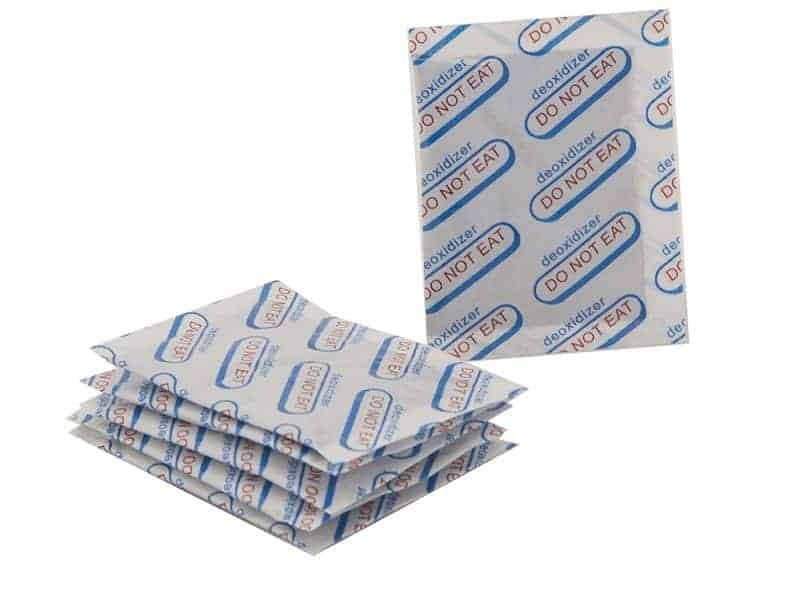
The best way to store oats long-term (more than a year) is with oxygen absorbers. These are little packets of iron that absorb oxygen from the air. Insects and their eggs can’t survive without oxygen, so that the oats will be safe from pests. Oxidation also won’t occur, so the oats will stay fresh and retain their nutrients. Oats stored with oxygen absorbers can last 25+ years.
For oxygen absorbers to work, the oats must be in air-tight packaging. Some options are:
Mylar bags:
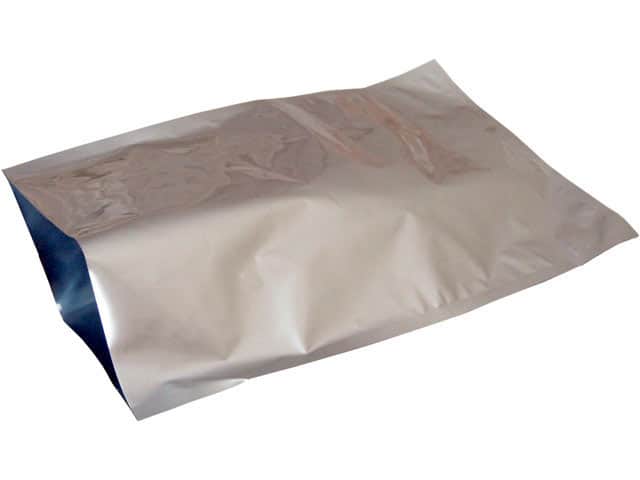
Mylar bags are made from a metallic-like material that doesn’t let any air pass through. Put the oats in the Mylar bag, add OAs, and seal. Oats stored this way can last 25+ years. Read more about how to use Mylar bags here.
Buckets with gamma lids:
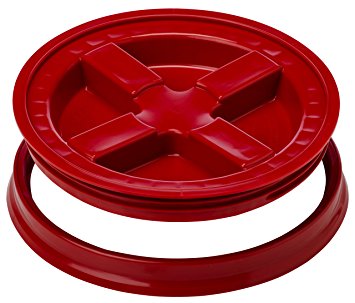
Food-grade buckets that use gamma lids provide a very secure seal. You can put a large number of oats into the bucket, throw some oxygen absorbers on top, and then seal the bucket. This is a good way to store large amounts of oats. The only downside is that you’ll need to add more oxygen absorbers each time you open the bucket.
#10 Cans:
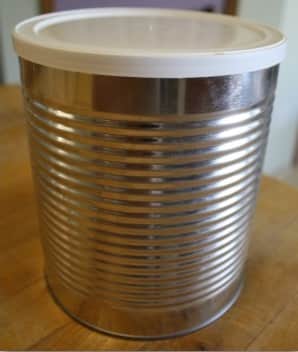
If you have access to a canning machine, you can store oats in #10 cans. Ultimately, I don’t recommend this because the cans are so expensive. It often ends up cheaper to just buy oats in #10 cans. Lots of survival food brands sell these. Read more about #10 cans here.
*Read more about how to use oxygen absorbers here.
**If you want to use desiccants and oxygen absorbers, the desiccant should go on the bottom of the container.
What about vacuum sealing?
Vacuum sealing removes air from the package. For foods that are sensitive to air, vacuum sealing can extend shelf life. However, it really doesn’t make that much of a difference: the oats won’t last much longer in vacuum sealer bags than they would in their original packaging.
Further, those vacuum sealer bags aren’t completely air-tight: some air and moisture will get through tiny holes in the bag. Speaking from experience, moths can also chew through vacuum sealer bags. So, if you want to store oats long-term, you are better off using oxygen absorbers + Mylar bags.
How Long Will Oats Last?
Oats will typically last 6-24 months in the pantry. If you store oats with oxygen absorbers in airtight packaging, then they can last 25+ years.
Some types of oats will last much longer than others, though. Steel-cut oats (which are oat grains that have been chopped up) contain many natural oils. These oils are very sensitive and will eventually start to go rancid, especially in the presence of oxygen or heat.
By contrast, rolled oats and instant oats are steamed and then flattened. This processing helps stabilize the oils, so these types of oats will last the longest. Oat flour is very finely ground and has more surface area so that it will last slightly less.
Oat Bran is the outer husk of whole oat groats. Bran contains many natural oils, so it will go bad in about 3 months. It isn’t recommended to store oat bran long-term, even with oxygen absorbers.
Most oatmeal packets contain powdered milk. The milk’s fats will start to go rancid over time, so oatmeal packets usually have the same shelf life as powdered milk.
Oat Shelf Life
| Type | Pantry | With Oxygen Absorbers |
|---|---|---|
| Steel cut oats | 12-18 months | 5-15 years |
| Rolled oats | 12-24 months | 25+ years |
| Instant oats | 12-24 months | 25+ years |
| Oat flour | 6-12 months | 10+ years |
| Oat bran | 3-12 months | Not recommended |
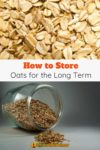


I have short grain white rice frozen in its original packaging. I want to move it out of my freezer and store in mylar bags with OA’s. Does the rice need to be defrosted in a certain way in order to deal with the moisture from being frozen, before I seal it in mylar bags? How to do this? Thank you.
Hi! I want to pack long term in Mylar bags, rolled oats with freeze dried fruit powder, ground flax, chia seeds, coconut flakes, some nuts and coconut milk powder. I was told that it is not safe. They say the oats could take on moisture. They recommend I cook and Freeze dried the oats. Is this something that has to be done? I have celiac, dairy intolerance and I can’t seem to find already prepared meals that fit my health issues. I do not own a freeze dryer but thought of cooking the oats and dehydrating them. Will this work or is it even necessary? Thank you
I would store the ingredients separately because the moisture content on each of those ingredients is very variable.
Hi
I recently watch a video prepper, who put two bay leaves in her oats, rice and beans before the OA and sealing the bag and bucket. Would the bay leaves add a bitter flavor to the oats?
Bay leaves are a natural way to prevent pests. I know lots of preppers use them when storing food WITHOUT oxygen absorbers. No idea why you’d want to use them if you are using OAs though. They’d definitely add an aroma to the food (probably not enough to really matter, but still).
Btw, I personally wouldn’t really on bay leaves alone to prevent pests. Lots of these natural methods work well, but aren’t realiable enough for me to trust them with my food supply. OAs will absolutely prevent insects!
When storing oats in Mylar bags in buckets, should I put OA’s in the Mylar bag with the oats as well as in the buckets before sealing or just in the bucket? If not using a bucket then I assume I definitely need the OA’s in the Mylar bag correct? I have 10 lbs of oats that will be going outdated on Sept.(it is now June 12th) this year so just want to extend the shelf life of these for a year perhaps by using the Mylar bags but will use them within 12 – 18 months.
You put the OAs in the Mylar bag. There is no point in putting OAs the bucket: the Mylar bags are sealed so any OAs in the bucket won’t have any effect.
I stumbled across this information. Thank you so much, I have learned a couple of things that I wasn’t sure of!
If I am storing flavored instant oatmeal packets do I need to poke a whole in the packet and then put each packet in the mylar bag with OA?
Yes, that’s correct: poke holes (or just cut the top off) packaging before storing with OAs. Otherwise the OA won’t be able to do its job.
I use groats to make milk and buy in bulk, but don’t use very quickly. Could I store in Mason jars? Do I need oxygen absorbers? If I stored this way, how long would they last?
Yes, you could store them in Mason jars with 2-part lids. They provide a nice, airtight seal. Mylar bags would also work. Stored like that, your oat groats should last 8 years. Just be warned that all foods — even when stored with O2 absorbers — will go bad in high temperatures. The fats start going rancid because of the heat. They will still be safe to eat but might get a bad odor or taste to them. To play it safe, maybe only package as much oat groats as you can rotate through within 1 year. 🙂
Do you need oxygen absorbers in Mason jars? Also is the 8 years Mason jars also? Or just mylar bags?
For long term storage, you’d also need OAs in mason jars. So long as the mason jars were kept somewhere away from light, you’d also get approx. 8 years of shelf life.
But I really don’t recommend storing emergency food in glass. If you do, make sure you’ve got some serious earthquake/hurricane/tornado-proof shelving to keep the jars safe!
When using oxygen absorbers in Mylar bags with rolled oats what will it look like? I did oats, rice and beans. The rice and beans are tightly packed now like all the oxygen is gone. The oats are not tightly packed. They are still squishy and it looks like not all the oxygen is out. I’ve tried it twice now. Second time I added more absorbers.
Food packed with O2 absorbers doesn’t always look all squished down. This is because they only remove oxygen and not nitrogen. But, since your beans andn rice did get squished down, you probably need to use more O2 absorbers in the oats. Remember, there can be a lot of air INSIDE the oats and not just around them.
I’m a little confused. When you vacuum seal, you are removing the air. How can anything like insect eggs survive without air? You mentioned a couple of times you don’t recommend vacuum sealing because the eggs could still hatch; bags or Mason jars. Please explain?
Because vacuum sealing only removes the air AROUND the food. There is still oxygen trapped inside the food. And it doesn’t even remove all of the air around the food — just most of it. Insects can definitely still hatch, even with reduced oxygen.
I purchased a 50 lb bag of whole oats grains and I’m wondering if this is worthwhile to save? I purchased it without much knowledge on the different types of oats for storage lol. So I’m not really sure how to proceed with it or if it’s worth the resources.
Me too! It’s been 4 years they have probably lost some nutrition but still good so far and no moths 🙂
How about storing coffee beans? How do you recommend to do it?
Here is that info: https://www.primalsurvivor.net/long-term-coffee-storage/
I can’t just put my oats in the bucket w OA, and close? They need to be in a mylar bag as well? Mylar bags are expensive. Same question applies to sugar flour, seeds, ?? Thanks
I would like to purchase many of the books and such you and others sell but to print out 60+ pages is expensive, are your tips available in print in book form?
Some people use OAs in buckets without a problem. But I personally don’t recommend it. Even “airtight” bucket lids will eventually start to leak. The plastic on the gasket seal will dry out, get brittle and allow air to seep in — thus making the OAs useless.
We don’t have the books in print form because it would be an expensive logistcal nightmare for us to print/warehouse/ship. You could read in digital format and just print the pages you need. 🙂
What’s the best way to microwave oats to kill eggs? I always have frozen them, but just bought 50 lbs of rolled oats and don’t have the freezer space unless I do small batches. I plan to store in Mylar w/ OAs, but I’ve had pantry moths as a child and want to be extra cautious to avoid that disaster!
If you are using OAs, then you really don’t need to freeze or microwave. If you really want to take the extra step though, then just make sure you microwave in smallish batches in a ceramic bowl (not plastic). Otherwise you get heat spots in the middle of the oats and some might scorch. It will take a LONG time!
I stored a lot of organic rolled oats in a 5-gal food-safe bucket with a tight-fitting lid a few years ago and put in some oxygen absorbers. (I do not remember how many I put in of the oxygen absorbers.) Now, several years later, I discovered the bucket is severely “sucked in” on two sides — obviously due to lack of oxygen. I have heard that lack of oxygen can cause botulism, but would or could this happen with my dry rolled oats? (I do live in a fairly humid climate.) I can’t even open the bucket at this point but once I get it sawed open (if necessary) how will I be able to tell if the oats have botulism? Should I just throw them out?
Lack of oxygen doesn’t cause botulism. Rather, botulism is able to grow in oxygen-free environments — but only in very moist or wet conditions (this is why botulism is a concern with home-canned foods). Oats are dry, so they won’t support botulism growth. We talk about botulism in more detail here: https://www.primalsurvivor.net/oxygen-absorbers/
To relieve the vacuum pressure in your bucket, you should just be able to puncture it. Put a small hole in the lid with an ice pick and relieve the vacuum and then you should have no trouble opening it.
I was just going to put my old-fashioned oats in glass mason jars and vacuum-seal them. Do I still need oxygen absorbers in them?
Vacuum sealing mason jars is pretty reliable (though, as someone who lives in an earthquake zone, I don’t put any of my emergency food stockpile in glass jars!). However, you could end up with an insect infestation in the oats. The eggs are already in the oats when you buy them and they hatch about a month or two later. See this post for info: https://www.primalsurvivor.net/bugs-weevils-moths-food-storage/
Insect eggs won’t hatch in an oxygen-free environment. For that reason, I prefer OAs for long-term food storage. If you use OA in mason jars, you don’t need to vacuum seal. Just put OAs in the jar and put on the two-piece lid.
Would oats do well dry canned and vacuum sealed with oxygen absorber’s in mason jars? Thanks!
You don’t need to dry can or vacuum seal. Just put the oats in the mason jars with OAs, then seal the lid. I still prefer mylar bags over glass though — you don’t want your food storage to shatter into a million pieces during a natural disaster.
Diane,
I was not familiar with sprouted oats until today. Found some “Sprouted Rolled Oats” on sale at COSTCO and picked up a bag to give them a try. (I am a steel cut oats kind of girl myself).
2 questions: Would you advise against trying to do long term storage of sprouted rolled oats as well?
Secondly, in terms of use, would I use these just like I would regular rolled oats (i.e. as meal extenders in meatloaf, etc., in granola, and oatmeal cookies)? Thanks!
Sprouted oats won’t store as long as unsprouted oats. For long-term storage, you are better off with rolled or instant oats. Or just stick to your favorite steel-cut oats and rotate through them within 5 years. And, yes, sprouted rolled oats can be used just like regular ones. Lots of people grind them into flour.
I noticed there are several mentions and references to products with milk powder …… and possibly a few misconceptions.
The two best ways to preserve most any food long term, is freeze drying and/or spray drying which puts the food through extreme temp. Etc to stabilize it and allow it to be preserved. Powdered Milks including Whole Milk (which is what I store) will keep just fine long term as it is almost always processed through one of these above methods. As long as it is in a sealed container with OA it will be fine. Hope this helps.
The issue with whole milk is that it contains lots of fats. Even with OAs and packaged in sealed containers like Mylar bags, fats still go rancid — especially in high temperatures. It’s really difficult for many people to keep their food preps at cool temperatures (I personally hardly ever turn on my AC). Thus why most recommendations say to store low-fat milk instead of whole milk. Rancid food is safe to eat in the sense it won’t make you immediately sick like bacterial contamination, but it tastes nasty!
Hello, I have instant flavored oats like brown sugar, apple, cinnamon. . . Will these be good to store with O2 absorbers and mylar bags? Or is it safer to stick with plain oats like old fashioned.
They should be fine to store with OAs in Mylar. I would still stick to storing plain oats though. The brown sugar in the instant oats might get weird and clumpy. The shelf life might be shorter too depending on what other ingredients are in there (a lot of them have milk powder).
I have the same question. I want to put my cinnamon oatmeal in mylar bag plus 02 absorber but don’t know if the cinnamon will make it go bad.
The cinnamon won’t make the oats go bad. The issue is that cinnamon has a shorter shelf life than oats. The cinnamon will still be safe to eat for yeras, but it will lose its flavor or go rancid as natural oils break down. If you plan on rotating through the food within a year or two, this isn’t an issue. Otherwise, store your cinnamon separately.
Side note: I’d still recommend storing the cinnamon separately. What if you run out of regular flour and want to grind up oats to make bread or something? Or add to beans to make veggie burgers? Everything would taste like cinnamon.
Vacuum pack in small amounts(bowl volume)and place in the freezer or fridge.
Hello! Any thoughts on whether sprouted oats or other sprouted grains/legumes can also be preserved long term? Thank you for all the good info!
I’m not sure about how long they last but it is definitely shorter than unsprouted. You’d likely be better off storing unsprouted long-term and then sprouting them.
Be warned though that not all may sprout after being in storage for a long time, especially if they were frozen first or stored with oxygen absorbers. And microwaved grains/legumes will definitely not sprout (microwaving kills insect eggs, so some people do that before storing).
How long do oat groats last? I have read I can use an oat flaker to get something similar to rolled oats. So would oat groats last the longest?
They surprisingly don’t last the longest. It is because they contain a lot of natural oils. By contrast, rolled oats are processed so they last longer. Personally, I can’t think of any reason to store oat groats unless you want to sprout them later down the line.
Ten lb boxes of Quaker Oats old fashioned oatmeal last approximately 9 years before the bug eggs within each box hatch. Technically the bugs should taste like oats because they’ve only eaten the oats.
You got lucky. I get Indian moths in my oats within a year. It’s probably because I get mine in bulk though. The moths and larvae don’t really have much taste, regardless of what they eat. It’s the texture that can be gross if there are a lot of them.
Hi, what could we do better? Any suggestions and also do you know of the botulism could be cooked out? Thanks in advance!
Botulism can never be cooked out with anything we have in our home. Here is an excerpt from the WHO:
Prevention of foodborne botulism is based on good practice in food preparation particularly during heating/sterilization and hygiene. Foodborne botulism may be prevented by the inactivation of the bacterium and its spores in heat-sterilized (for example, retorted) or canned products or by inhibiting bacterial growth and toxin production in other products. The vegetative forms of bacteria can be destroyed by boiling but the spores can remain viable after boiling even for several hours. However, the spores can be killed by very high temperature treatments such as commercial canning.
Commercial heat pasteurization (including vacuum packed pasteurized products and hot smoked products) may not be sufficient to kill all spores and therefore the safety of these products must be based on preventing bacterial growth and toxin production. Refrigeration temperatures combined with salt content and/or acidic conditions will prevent the growth of the bacteria and formation of toxin.
Hope this helps. If in doubt, through it out. It’s not worth the risk.
You have misunderstood the information.
Botulism SPORES cannot be (easily) killed. However, the spores do not make us sick. It is a toxin produced by the spores. This CAN be killed. Here is the info from WHO (https://www.who.int/news-room/fact-sheets/detail/botulism):
“Though spores of C. botulinum are heat-resistant, the toxin produced by bacteria growing out of the spores under anaerobic conditions is destroyed by boiling (for example, at internal temperature greater than 85 °C for 5 minutes or longer). Therefore, ready-to-eat foods in low oxygen-packaging are more frequently involved in cases of foodborne botulism.”
If you heat up a canned item you aren’t sure about you can eat it. You can check with your states extension office to see if there are any different guidelines for your state. For instance Colorado has different boiling times because of their altitude. High acid foods you don’t have to worry about ie jams, jellies, pickles, etc… . You don’t have to boil canned items you are sure have been canned correctly, but if you aren’t sure about an item, you can boil for 10 min plus 1 minute for every 1000 feet above sea level. Personally I know every now and again I open a jar and realize I was distracted and didn’t make sure the lid sucked in air rather than expelling it. That’s when I make sure to boil for 10 min.